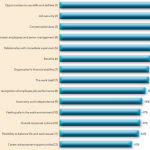How to achieve employee satisfaction
Employee satisfaction reflects the personnel’s level of contentment with their company. Why is it important? Because it’s correlated with # Employee tenure, % Employee turnover and # Employee commitment index, 3 important KPIs that influence business growth.
For example, an employee may be excited about his new job in the first 1 or 2 months, but after that point, if there is no intrinsic motivation and he is not satisfied with the job, his effort will be minimal and he could eventually leave.
A 2003 study, conducted by Rudman and quoted by Kristen Gregory, shows that an American’s career comprises an average of 8 jobs throughout. The turnover rate is very high and employee satisfaction plays a major part. Having this in mind, the first thing to do, regarding employee satisfaction, is to measure it and after that, to improve the areas with the lowest score. The most common and effective way to measure it is the survey.
An example of how the employee satisfaction survey should look like, comes from Republic of Macedonia State Statistical Office, which has implemented an extensive survey based on 12 perspectives. Out of these areas, 8 seem to have a major impact and can also be adapted to other types of organizations:
1. Management – reflects the employee satisfaction with top or middle management
Ex: On a scale from 1 – 10, where 1 stands for unsatisfied and 10 for extremely satisfied, you can rate how happy you are with:
- communication between you and your immediate supervisor
- your immediate supervisor’s conflict resolution skills
2. Employee competence – reflects the employee’s satisfaction with career opportunities and work activities, as compared to the respondent’s competencies.
Ex: On a scale from 1 to 10, you can rate your level of satisfaction with:
- the career advancement opportunities
- the work activities, compared to your skills and the opportunities for improving your competency level
3. Training opportunities – refers to employee satisfaction with training efficiency and opportunities
Ex: On a scale from 1 to 10, how much do you agree with the following:
- training helped me improve my work efficiency
- training helped me advance in my career
4. Working conditions – refers to employee satisfaction with technical working conditions
Ex: On a scale from 1 to 10, how satisfied are you with:
- the access to equipment necessary for performing your tasks
- your office
5.Income – refers to employee satisfaction regarding their salary
Ex: On a scale from 1 to 10, how satisfied are you with:
- your salary compared to the work you perform
- the current model of reward and recognition
6. Employee relations – refers to employee satisfaction regarding the relations in the company
Ex: On a scale from 1 to 10 how satisfied are you with:
- respect from your co-workers
- possibilities to receive assistance from co-workers when necessary
7. Workload – refers to employee satisfaction regarding their efficiency
Ex: On a scale from 1 to 10, how satisfied are you with:
- current fixed working hours
- workload pressure
8. Responsibility – refers to employee satisfaction regarding the company’s responsibility
Ex: On a scale from 1 – 10, you can rate your level of satisfaction with:
- how employees spend their working time
- immediate supervisor’s responsibility toward employees
After evaluating the areas above, the management team can create initiatives where improvement is needed. Management should have a positive effect on, and support the company’s employees. Satisfied personnel will remain in the company longer, will work harder and this will ultimately reduce labor costs.
References:
- Gregory, K. (2011), The importance of employee satisfaction
- Republic of Macedonia State Statistical Office (2009), Employee satisfaction survey
Image source:

Tags: Employee Satisfaction






